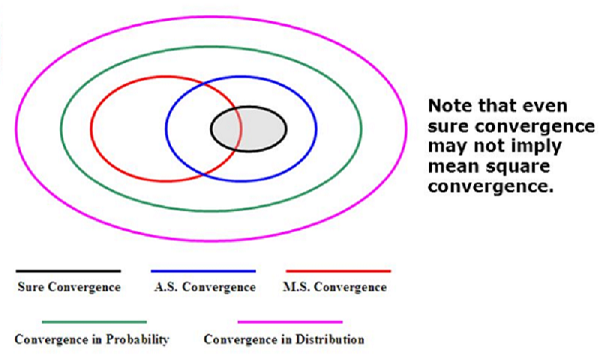Asymptotic Equipartition Property
The asymptotic equiparitition property (AEP) is central in information theory and is the consequence of the law of large numbers.
Types of Convergence
A random variable is: a mapping from its set of sample values \(\Omega\) onto \(\cal R\).
In the cases we have been discussing, \(\Omega = \cal X\) and we map onto \([0,1]\).
Sure Convergence
A random sequence \(X_1, . . .\) converges surely to r.v. \(X\) if \(\forall \xi \in \Omega\) the sequence \(X_n(\xi)\) converges to \(X(\xi)\) as \(n \to \infty\).
Almost Sure convergence
Also called convergence with probability 1, the random sequence converges a.s. (w.p. 1) to \(X\) if the sequence \(X_1(\xi), . . .\) converges to \(X(\xi)\) for all \(\xi\) except possibly on a set of \(\Omega\) of probability 0.
Convergence in Probability
The sequence converges in probability to \(X\) if \(\forall \epsilon > 0, \lim_{n \to \infty} P_r (|X_n - X| > \epsilon) \to 0\).
Convergence in Distribution
The sequence converges in distribution if the cumulative distribution function \(F_n(x) = P_r(X_n \le x)\) satisfies \(\lim_{n \to \infty} F_n(x) \to F_X(x)\) at all \(x\) for which \(F\) is continuous.
Venn diagram of relations among types of convergence:

Weak Law of Large Numbers
\(X_1, X_2, . . .\) are i.i.d, finite mean \(\mu\) and variance \(\sigma^2\), then \(A_X^n \to \mu\) in probability, where \(A_X^n = {X_1 + ... + X_n \over n}\)
Strong Law of Large Numbers
If \(X_i\) are i.i.d, and \(E_X (|X|) < \infty\), then
The difference between Strong and Weak lies in the limiting behavior of an infinite sequence of rv’s, but this difference is not relevant here.
Strong versus Weak Typicality Intuition
\(\cal X = \{\clubsuit, \diamondsuit, \heartsuit, \spadesuit\}\) with pmf \(p_X = (0.5, 0.25, 0.125, 0.125) \Rightarrow H(x) = H(0.5,0.25,0.125,0.125) = 1.75\) bit.
E.g. Sample sequence consisting of eight i.i.d samples:
-
Strongly typical: all sequence with correct proportions
\(\clubsuit\clubsuit\clubsuit\clubsuit\diamondsuit\diamondsuit\heartsuit\spadesuit \Rightarrow -\log p(x) = 14 = 8H(x)\). -
Not typical at all: \(-\log p(x) \neq nH(x)\)
\(\spadesuit\spadesuit\spadesuit\spadesuit\spadesuit\spadesuit\spadesuit\spadesuit \Rightarrow -\log p(x) = 24 \neq 8H(x)\). -
Weekly typical: \(-\log p(x) = nH(x)\)
\(\clubsuit\clubsuit\diamondsuit\diamondsuit\diamondsuit\diamondsuit\diamondsuit\diamondsuit \Rightarrow -\log p(x) = 14 = 8H(x)\).
Asymptotic Equipartition Propert(AEP)
APE
If \(X_1, X_2, ... , X_n {i.i.d. \atop \sim} p\), then
** Typical Set**
Reference:
- Thomas M. Cover, Joy A. Thomas. (2006). Elements of Information Theory. John Wiley & Sons.
- Natasha Devroye. ECE 534: Elements of Information Theory. University of Illinois at Chicago. https://www.ece.uic.edu/ECE534 .
A good person! More about the author →